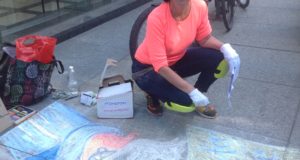By Anthony Marcusa –
As drivers continue attempting to save time wherever possible in an increasingly congested city, some quiet residential streets are feeling the negative effects.
Two of the casualties are Brooklyn Ave. and Pape Ave., two strictly residential and parallel streets between Queen St. E. and Dundas St. E. in Leslieville. Motorists use the two avenues, and their adjoining streets, as major arteries, creating safety concerns among residents.
Patti Abrams, a mother and seven-year resident of Brooklyn Ave., has taken up the cause to calm traffic in the area alongside two other residents.
“For a number of years, there have been a few of us who believe traffic moves too fast here,” began Abrams. On both Pape and Brooklyn, “people are not stopping at signs, traveling too fast, and just being reckless.”
“It’s just a matter of time before someone gets seriously hurt.”
It is indeed a straight shot from Queen to Dundas, something that appeals to drivers. Two separate items that may go unnoticed to those who don’t live in the area is that Brooklyn is a one-way street running northbound, and that while Pape is a major thoroughfare north of Dundas, its quieter residential south end is not designed for commuters.
Abrams and other concerned residents met with the city to talk about forming an exploratory group and studying the street. The study, however, cannot be done until the fall due to the anomalous nature of summertime traffic—the analysis will have to take place in September and October. Meetings will resume to explore recommendations from the study.
Abrams stresses that a neighbourhood consensus is important and in fact vital to moving forward. “We want to work together as much as possible so that everyone is happy with whatever happens.”
“We want to know if people are opposed to anything; this is a nice, friendly neighbourhood and we want to keep it that way.”
This issue is not new to Brooklyn Ave. In early 2007, the city’s transportation services office, at the request of council as urged by concerned residents, studied the street but concluded traffic calming measures should not be installed. Based on their guidelines, Brooklyn Ave. did not receive the minimum number of 1000 cars in one day to warrant such measures. Calming methods include the installation of speed humps, but the cost of four would be $12,000, and also are detrimental to nearby emergency services.
This time around, however, Abrams and supporters are optimistic. Toronto Danforth councilor Paula Fletcher, who was in office and supported it when the request was made four years ago, backs the proposal once more. Plus, area residents are becoming more vocal.
In addition to speed hump, potential solutions include increased signage including the first “You Are Now Entering a Residential Area” sign, reduced speed limits, and staggered alternate side-of-the-street parking. The last option is realistic and “doesn’t create a straight view down the street, which will slow cars.”
Abrams hopes that this will help other areas of the city too, and that whatever solutions arise in the months to come will be applicable and available similar streets around the city.
“Obviously we’re not going to be the only neighborhood in the city with these problems, so we’re not looking for exclusivity or special treatment,” Abrams concluded. “We should have answers that can be implemented everywhere and help everyone.”
 TheBulletin.ca Journal of Downtown Toronto
TheBulletin.ca Journal of Downtown Toronto


